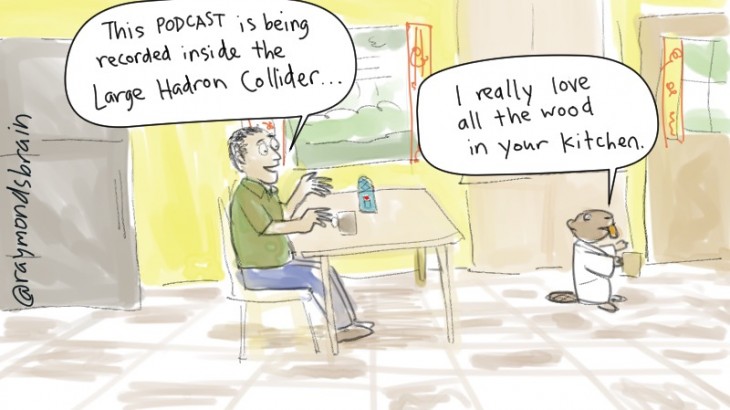Raymond Nakamura and Lisa Willemse, Multimedia co-editors
<Play the theme music, which is an original composition or available through Creative Commons that elicits a sense of Canada as well as science and multimedia…>
Raymond <who sounds as though he’s speaking from the bottom of a deep well>: Welcome to another episode of “Multimedia Posts on Science Borealis You Should Know”, with me, Raymond Nakamura, and…
Lisa: … and me, Lisa Willemse. Today we’re talking about podcasts. Science podcasts, to be exact, and if you want to be really specific, science podcasts with a Canadian twist. <Play quintessential Canadian sound, e.g., Hockey Night in Canada theme song – quintessential version, 1960s radio clip of Marshall McLuhan, or the call of a loon.>.
Raymond: That’s right Lisa. Santa as a Scientist, posted back in December by Genome Alberta, is great example of this podcast subspecies. And it demonstrates how profoundly insightful this medium can be.
Lisa: Insightful is absolutely right. I suppose this is why podcasts are so pervasive — there are so many amazing podcasts available, on just about any topic imaginable. I sometimes find that strange, given that podcasts have been called “radio on demand” and radio is archaic compared to all the other forms of multimedia we now have access to. But what makes podcasts shine, in my opinion, is their reliance on good storytelling. And a good story never dies. Just ask Homer. < Play Homer Simpson quote: “Kids, you tried your best and you failed miserably. The lesson is, never try.”> No, not that Homer!
Raymond: Speaking of the other Homer, I did a project in high school on blood imagery in the Iliad. It was an excuse to draw some really gross pictures. But getting back to sound. I think storytelling with sounds is a more active experience than watching video because you have to imagine what is going on. And it’s often fun to imagine what the person looks like from how they sound. <In a non-Darth Vader-y James Earl Jones voice.> Can you tell I am ripped like Bruce Lee in his prime?
Lisa: I’ve always pictured you as Bruce Lee. Though, after listening to your Sounds Japanese Canadian to Me podcast – yes, I know it’s not a science podcast, but it’s interesting and what’s a good co-host for if she can’t plug your work? – I’d have to say you sound like a less-caffeinated Bruce Lee with a better haircut.
Raymond: Thanks for the earplug. <Play snare drum and cymbal crash.> Digging more deeply into podcasts on Science Borealis, Lucas Kavanagh has begun posting a series of podcasts aboard the Joides Resolution, a ship drilling into the bottom of the Indian Ocean.
Lisa: Yes, I like them and not only because it’s an interesting topic. Having never been on a ship like that before, I found myself listening to the sounds more closely to see if I could figure out what they were. <Play foghorn blowing.>
The other really neat thing about Lucas’ podcasts is that they show just how versatile podcasting can be. I mean, he’s in the belly of a ship in the middle of the Indian Ocean and he’s producing and posting these stories with clean sounds!
Raymond: I find that podcasts almost make me look forward to washing the dishes. <Play sounds of dishes clattering and pots clanging and soapy water spilling out of the sink onto the floor.> Sometimes I may miss some baked-on bits and this may be bad for developing mindfulness. But the On Your Mind neuroscience podcast could balance this out with its thoughtful conversations about research on how the mind works.
Lisa: Peace of mind is always a goal to aspire to. Personally, I like listening to podcasts when I’m driving, but maybe I’d get more housework done if I began listening around the house.
Raymond: Since we’ve both been on the creating and listening side of podcasts, I wonder if we might provide a short list of recommendations for those contemplating this fine art?
First, get a good microphone. It need not be expensive – there are good entry-level mics for around $100 – but clear sound is a must for podcasts. Obviously.
Lisa: Second, grab natural sounds to enhance your podcast if you’re not interviewing or recording on location. There are plenty of places to get sound effects and music at low or no cost. Freesound is one of our favourites.
Raymond: Third, decide whether or not to script. Short podcasts lend themselves to scripting, which is essential if you’re trying to share concise bits of science. 60-second Science is a great example of this. But for longer podcasts with one or more hosts or interviews, scripting can often sound…well, scripted. Better to stick with well-defined topics and let your natural personality shine through.
Lisa: And finally, edit your recordings to get rid of the ums and ahs. Like microphones, you can spend a lot, a little, or nothing on editing software. Both of us have used Audacity, which is a free download and does the job nicely.
Raymond: Now, you are ready to release your beast. Again, there are a number of different options. The Audacity wiki gives a basic rundown of all you’ll need to know.
Lisa: We look forward to hearing about your Canadian science podcasts. If you have any podcast tips, please add them to the comments.
On a personal note, this is my final romp with Raymond as multimedia co-editor on Science Borealis.
<Play swan song, if such a thing actually exists.>
Raymond: It has been a pleasure and privilege to romp with you. And thank you for your continued contributions to Science Borealis and science communications generally <uncontrolled sobbing>.
To all our readers, I could use a new coeditor to fill Lisa’s headphones as Multimedia co-editor.
<Play Auld Lang Syne in the background.>
*Original artwork by Raymond Nakamura. Used with permission.




